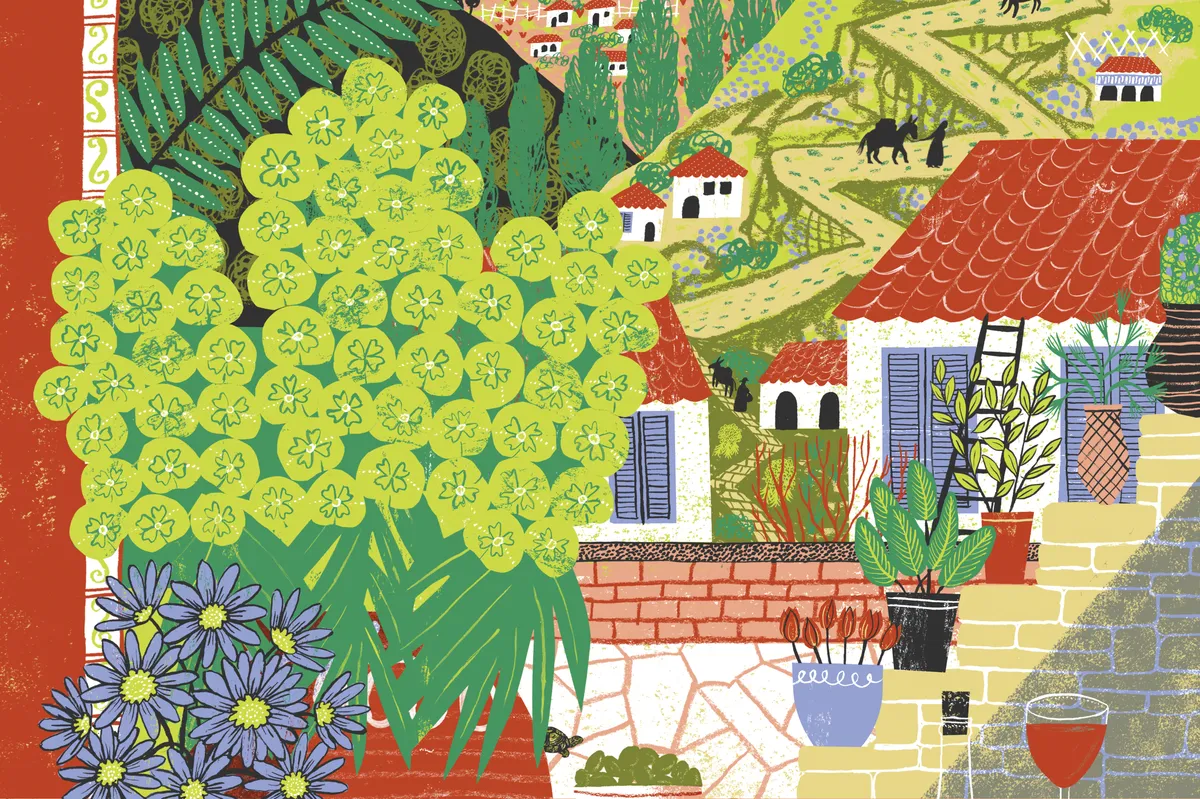The main road narrows to a bumpy lane as you head along the coast from Kalamata towards the southernmost point of mainland Europe. I wanted to complete a loop that would draw me into the spectacular desolate, landscapes of deep Mani then continue up the eastern side of the peninsula and into the snow-capped peaks and deep gorges of the majestic Taygetos Mountains before returning through the Langada Gorge, home to Thalictrum orientale, with a pass at 1,300m. I hoped to find wild tulips. I had read that Tulipa goulimyi and T. orphanidea grew in a few locations on the Mani Peninsula. To my delight I got lucky, and found the rare crimson T. goulimyi on my second day in the hills.

When to go
The peak for the lowlands is from late March to late April, but the season in the mountains above 1,000m extends into July. Even if you visit in autumn it’s colourful, with cyclamen, crocuses, colchicums and the glossy, yellow flowers of Sternbergia lutea.
Where to go
Driving south I marvelled at the abundance of technicolour vegetation spilling on to the shabby asphalt. To great excitement I stopped twice for tortoises to shimmy across my path. Kastania was a highlight of the outer Mani, I was too early in the season to find lunch but wine and a delicious snack appeared from a house on the village square. Cobbled, ancient mule tracks (kalderini) snaked out of the village and on to the mountain. Here in shady spots were vigorous colonies of Cyclamen rhodium subsp. peloponnesiacum, Anemone blandaand the scallop-leaved Saxifraga rotundifolia subsp. chrysosplenifolia offering its starry white flowers up for admiration. Nearby I found blue, courtesy of the pretty endemic Scilla messeniaca, and the occasional Iris unguicularis peeping out of the grass. Orchis italica, scarlet Anemone coronaria and yellow bee orchids also thrived in the sun. Here too the generous, lilac flowers of Campanula andrewsii sprawled over smooth limestone boulders and caught my eye as we walked through the prickly phrygana (spiny vegetation that thrives here).
The stony old olive groves are not heavily cultivated, and are full of flowers. Tongue orchids: the larger, darker Serapias vomeracea subsp. orientalis and its pale little sister Serapias lingua, magenta soapwort, Saponaria calabrica, Vicia melanops and Cerinthe retortaabound. On the eastern aspect, the village of Anavryti (920m) has a wonderful café serving mountain tea (Sideritis syriaca), which you need to soothe your nerves after the hair-raising ascent. From here there are many trails to follow. In three hours I reached the ancient Byzantine settlement of Mystras, an open archaeological site on the slopes of Mount Taygetos. I found many botanical treasures en route, and, among the ruins, protection from grazing promotes yet more floral diversity. Here I stumbled on a tiny, half-ruined room, a few fragments of fresco persisted on the otherwise rough stone wall. Painted flowers, among them a slender tulip, the ancient red pigment faded to a deep ox-blood black.
Plant to grow at home
Observation of any plant growing in its native habitat brings a greater understanding of how to grow it well, and what to plant next to it. Euphorbia characias subsp. wulfenii is popular in cultivation, and has been since its introduction during the reign of Elizabeth I. Valued for its architectural form, great stature and long season of interest, it is often confused with the other subspecies of E. characias. This has a more compact habit and modest, dark-centered flowerheads; so it is good to note that the two are found in different areas of the Mediterranean: subsp. characias in the western region and subsp. wulfenii in the east.
This wonderful evergreen spurge is a perennial with biennial flower stems. You cut them back to the base just after flowering in early summer, making space for new stems that quickly extend with the promise of dramatic chartreuse flower whorls the following spring. It is generally hardy, but requires free-draining soil and is appreciative of both space and sun.
In the Mani, vibrant Euphorbia flowers were plentiful but it looked most remarkable growing with just two companions; a wispy grass and drifts of scarlet Anemone coronaria. The red peacock anemone, A. pavonina, also grows here (the two are almost identical but this one has undivided stem leaves and narrower, more numerous petals). To get the same effect grow clumps of the flame anemone, A. x fulgens, which is slightly taller and more likely to thrive in a damp climate, and gives a fiery shot of spring colour.
Guides and maps
Mani: Travels in the Southern Peloponnese by Patrick Leigh Fermor (1958). (Not really a travel guide, but a superlative companion to the region, its people, places and rich history – and the inspiration for my trip).
Southern Peloponnese Walks and Car Tours by Michael Cullen (Sunflower Books, 2014).
Flowers of Greece and the Balkans: A Field Guide by Oleg Polunin
(Oxford Paperbacks, 1987).
You can also find up-to-date information on hiking routes, public transport timetables and events at insidemani.gr
Where to stay
Traditional Hotel Itilo Neo Itilo, Anatoliki Mani 230 62, Greece
Tel +30 27330 59222, hotelitilo.gr
A boutique hotel with private terraces, pedigree goats and wonderful hosts.
Taleton Sparti Country Hotel, Xirokambi 230 54, Greece
Tel +30 2731 035150, taleton.gr
Eco boutique hotel, set in the foothills of Mount Taygetos. With easy access to many walking routes.
If you want to discover more amazing places to hunt for plants, subscribe to our digital edition here and read the other features in Hannah's series.